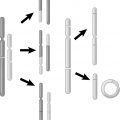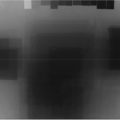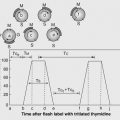25
CHEMOTHERAPY AND TARGETED AGENTS
NIKHIL JOSHI AND NEIL WOODY
Question 1
What are the broad classifications of chemotherapy agents?
Question 3
What is the mechanism of action of cisplatin? What are some of its toxicities?
Question 1 What are the broad classifications of chemotherapy agents?
Answer 1
Alkylating agents—these drugs substitute hydrogen atoms for alkyl groups (methyl-, ethyl-, etc.) on the DNA. Alkylating agents are subdivided into nitrogen mustards, ethylenimine derivatives, alkyl sulfonates, triazine derivatives, and nitrosoureas.
Antibiotics—these directly bind or intercalate (insert between layers) into DNA, preventing replication or RNA synthesis.
Antimetabolites—chemicals that mimic normal molecules in cells. These can act in several ways such as substituting for a normal drug (cytarabine substituting for cytosine in DNA synthesis), competing with a normal enzyme substrate (5-fluorouracil competing with uracil for binding to thymidylate synthetase), or by inhibiting a key enzyme related to the manufacture of nucleotides (methotrexate).
Mitotic inhibitors—these inhibit construction or deconstruction of the mitotic spindle (Vinca alkaloids and taxanes).
Topoisomerase inhibitors—these inhibit enzymes responsible for twisting and coiling of DNA (e.g., Etoposide).
Hall EJ, Giaccia AJ. Chemotherapeutic agents from the perspective of the radiation biologist. In: Hall EJ, Giaccia AJ, eds. Radiobiology for the Radiologist. 7th ed. Philadelphia, PA: Lippincott Williams & Wilkins; 2012:448–489.
Question 3 What is the mechanism of action of cisplatin? What are some of its toxicities?
Answer 3
Cisplatin undergoes an aquation reaction and then binds to DNA, causing interstrand and intrastrand DNA adducts. This DNA crosslinking damages the DNA structure, causing problems with mitosis, and initiates apoptosis that eventually leads to cell death. Cisplatin can cause neutropenia, thrombocytopenia, ototoxicity, nephrotoxicity, nausea, and vomiting.
Hall EJ, Giaccia AJ. Chemotherapeutic agents from the perspective of the radiation biologist. In: Hall EJ, Giaccia AJ, eds. Radiobiology for the Radiologist. 7th ed. Philadelphia, PA: Lippincott Williams & Wilkins; 2012:448–489.
Question 4
What is the mechanism of action of paclitaxel? What are some of its toxicities?
Question 6
What is the mechanism of action for 5-fluorouracil (5-FU)? What are some indications for its usage?
Question 4 What is the mechanism of action of paclitaxel? What are some of its toxicities?
Answer 4
Paclitaxel binds to the beta subunit of tubulin in the mitotic spindle and stabilizes the microtubule assembly, thus preventing disassembly and blocking mitosis. This causes a premitosis cell cycle block and activation of apoptosis. Paclitaxel can cause neutropenia, alopecia, and neuropathy. Ixabepilone is an epothilone B analogue that has more potent antitumor activity in vitro than paclitaxel. It preferentially inhibits the beta III-tubulin isotype of the microtubules.
Dumontet C, Jordan MA, Lee FY. Ixabepilone: targeting βIII-tubulin expression in taxane-resistant malignancies. Mol Cancer Ther. 2009;8(1):17–25.
Question 6 What is the mechanism of action for 5-fluorouracil (5-FU)? What are some indications for its usage?
Answer 6
5-FU inhibits the enzyme thymidylate synthetase. This prevents the formation of thymidine and thus cancers die due to a lack of thymidine. Folinic acid or leucovorin enhances the stability of 5-FU—thymidylate synthetase interaction and hence enhances its cytotoxicity. 5-FU is used in the treatment of head and neck cancer, colon cancer, rectal cancer, pancreatic cancer, and breast cancer.
Longley DB, Harkin DP, Johnston PG. 5-fluorouracil: mechanisms of action and clinical strategies. Nat Rev Cancer. 2003;3:330–338.
Question 8
What is the use and mechanism of action for leucovorin rescue with high-dose methotrexate? What is one indication for high-dose methotrexate use?
Question 8 What is the use and mechanism of action for leucovorin rescue with high-dose methotrexate? What is one indication for high-dose methotrexate use?
Answer 8
Leucovorin is a 5-formyl derivative of tetrahydrofolic acid, which gets converted to tetrahydrofolate, thus bypassing the enzyme dihydrofolate reductase that is blocked by methotrexate. Thus, it can be used to rescue normal cells after high-dose methotrexate. Doses of methotrexate above 3 g/m2 are usually considered high dose.
High-dose methotrexate is used in the treatment of primary central nervous system (CNS) lymphoma. Precautions must be taken to ensure high-volume urine flow and alkaline urine. This prevents the precipitation of methotrexate in urine, thereby preventing nephrotoxicity.
Treon SP, Chabner BA. Concepts in use of high-dose methotrexate therapy. Clin Chem. 1996;42:1322–1329.
Question 10
What is the mechanism of pemetrexed? What are some of its main indications?
Question 12
How does Mesna prevent the cystitis associated with ifosfamide?
Question 10 What is the mechanism of pemetrexed? What are some of its main indications?
Answer 10
Pemetrexed is an antifolate chemotherapy agent, which inhibits thymidylate synthase, dihydrofolate reductase, and glycinamide ribonucleotide formyltransferase, thereby preventing DNA and RNA synthesis, leading to cell death. Folic acid and vitamin B12 supplementation are recommended on treatment with pemetrexed. It is mainly used for nonsquamous lung cancer and mesothelioma.
Scagliotti G, Hanna N, Fossella F, et al. The differential efficacy of pemetrexed according to NSCLC histology: a review of two phase III studies. Oncologist. 2009;14:253–263.
Stay updated, free articles. Join our Telegram channel

Full access? Get Clinical Tree






